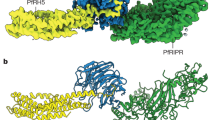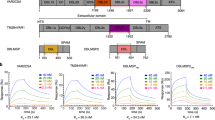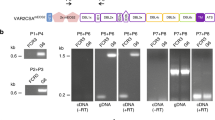Abstract
Infections with the malaria parasite Plasmodium falciparum are characterized by sequestration of erythrocytes infected by mature forms of the parasite. Sequestration seems critical for the survival of the parasite, but may lead to excessive binding in the microvasculature and death of the human host. We report here that a novel electrondense fibrillar structure, containing immunoglobulins M or M and G, is found at the surface of infected erythrocytes that adhere to host cells. In cases of cerebral malaria, fibrillar strands are also seen in the microvasculature at autopsy. Our findings may explain the adhesive mechanism by which malaria–infected erythrocytes cause the vascular obstruction seen in complicated malaria infections.
This is a preview of subscription content, access via your institution
Access options
Subscribe to this journal
Receive 12 print issues and online access
$209.00 per year
only $17.42 per issue
Buy this article
- Purchase on Springer Link
- Instant access to full article PDF
Prices may be subject to local taxes which are calculated during checkout
Similar content being viewed by others
References
Miller, L.H., Good, M.F. & Milon, G. Malaria pathogenesis. Science 264, 1878–1883 (1994).
MacPherson, G.G., Warrell, M.J., White, N.J., Looareesuwan, S. & Warrell, D.A. Human cerebral malaria: A quantitative ultrastructural analysis of parasitized erythrocyte sequestration. Am. J. Pathol. 119, 385–401 (1985).
Howard, R.J. & Gilladoga, A.D. Molecular studies related to the pathogenesis of cerebral malaria. Blood 74, 2603–2618 (1989).
Trager, W., Rudzinska, M.A. & Bradbury, P.C. The fine structure of Plasmodium falciparum and its host erythrocyte in natural malarial infections in man. Bull. WHO 35, 883–885 (1966).
Miller, L.H. The ultrastructure of red cells infected by Plasmodium falciparum in man. Trans. R. Soc. Trap. Med. Hyg. 66, 459–462 (1972).
Ruangjirachuporn, W. et al. Cytoadherence of knobby and knobless Plasmodium falciparum-infected erythrocytes. Parasitology 102, 325–334 (1991).
Carlson, J. et al. Human cerebral malaria: Association with erythrocyte resetting and lack of anti-rosetting antibodies. Lancet 336, 1457–1460 (1990).
Treutiger, C.J. et al. Rosette formation in Plasmodium falciparum isolates and anti-rosette activity of sera from Gambians with cerebral or uncomplicated malaria. Am. J. Trap. Med. Hyg. 46, 503–510 (1992).
Ringwald, P. et al. Parasite virulence factors during falciparum malaria: Resetting, cytoadherance & modulation of cytoadherance by cytokines. Infect. Immun. 61, 5198–5204 (1993).
Rowe, A., Obeiro, J., Newbold, C.I. & Marsh, K. Plasmodium falciparum rosetting is associated with malaria severity in Kenya. Infect. Immun. 63, 2323–2326 (1995).
Hidayat, A.A., Nalbandian, R.M., Sammons, D.W., Fleischman, J.A. & Johnson, T.E. The diagnostic histopathologic features of ocular malaria. Ophthalmology 100, 1183–1186 (1993).
Riganti, M. et al. Human cerebral malaria in Thailand: A clinico-pathological correlation. Immunol. Let. 25, 199–206 (1990).
Barnwell, J.W. et al. A human 88-kD membrane glycoprotein (CD36) functions in vitro as a receptor for a cytoadherence ligand on Plasmodium falciparum-infected erythrocytes. J. Clin. Invest. 84, 765–772 (1989).
Berendt, A.R., Simmons, D.L., Tansey, J., Newbold, C.I. & Marsh, K. Intercellular adhesion molecule-1 is an endothelial cell adhesion receptor for Plasmodium falciparum. Nature 341, 57–59 (1989).
Ockenhouse, C.F. et al. Human vascular endothelial cell adhesion receptors for Plasmodium falciparum-infected erythrocytes: Roles for endothelial leukocyte adhesion molecule 1 and vascular cell adhesion molecule 1. J. Exp. Med. 176, 1183–1189 (1992).
Handunnetti, S.M. et al. Involvement of CD36 on erythrocytes as a resetting receptor for Plasmodium falciparum-infected erythrocytes. Blood 80, 2097–2104 (1992).
Fujioka, H. et al. A nonhuman primate model for human cerebral malaria: Rhesus monkeys experimentally infected with Plasmodium fragile. Exp. Parasitol. 78, 371–376 (1994).
Aikawa, M. Human cerebral malaria. Am. J. Trap. Med. Hyg. 39, 3–10 (1988).
Nagatake, T. et al. Pathology of falciparum malaria in Vietnam. Am. J. Trap. Med. Hyg. 47, 259–264 (1992).
Roberts, D.D. et al. Thrombospondin binds falciparum malaria parasitized erythrocytes and may mediate cytoadherence. Nature 318, 64–66 (1985).
Author information
Authors and Affiliations
Rights and permissions
About this article
Cite this article
Scholander, C., Treutiger, C., Hultenby, K. et al. Novel fibrillar structure confers adhesive property to malaria–infected erythrocytes. Nat Med 2, 204–208 (1996). https://doi.org/10.1038/nm0296-204
Received:
Accepted:
Issue Date:
DOI: https://doi.org/10.1038/nm0296-204
This article is cited by
-
Insights on Rosetting Phenomenon in Plasmodium vivax Malaria
Current Clinical Microbiology Reports (2021)
-
Rosettes integrity protects Plasmodium vivax of being phagocytized
Scientific Reports (2020)
-
Variant surface antigens of Plasmodium falciparum and their roles in severe malaria
Nature Reviews Microbiology (2017)
-
Functional analysis of monoclonal antibodies against the Plasmodium falciparum PfEMP1-VarO adhesin
Malaria Journal (2016)
-
Asymmetry of blood flow and cancer cell adhesion in a microchannel with symmetric bifurcation and confluence
Biomedical Microdevices (2011)



